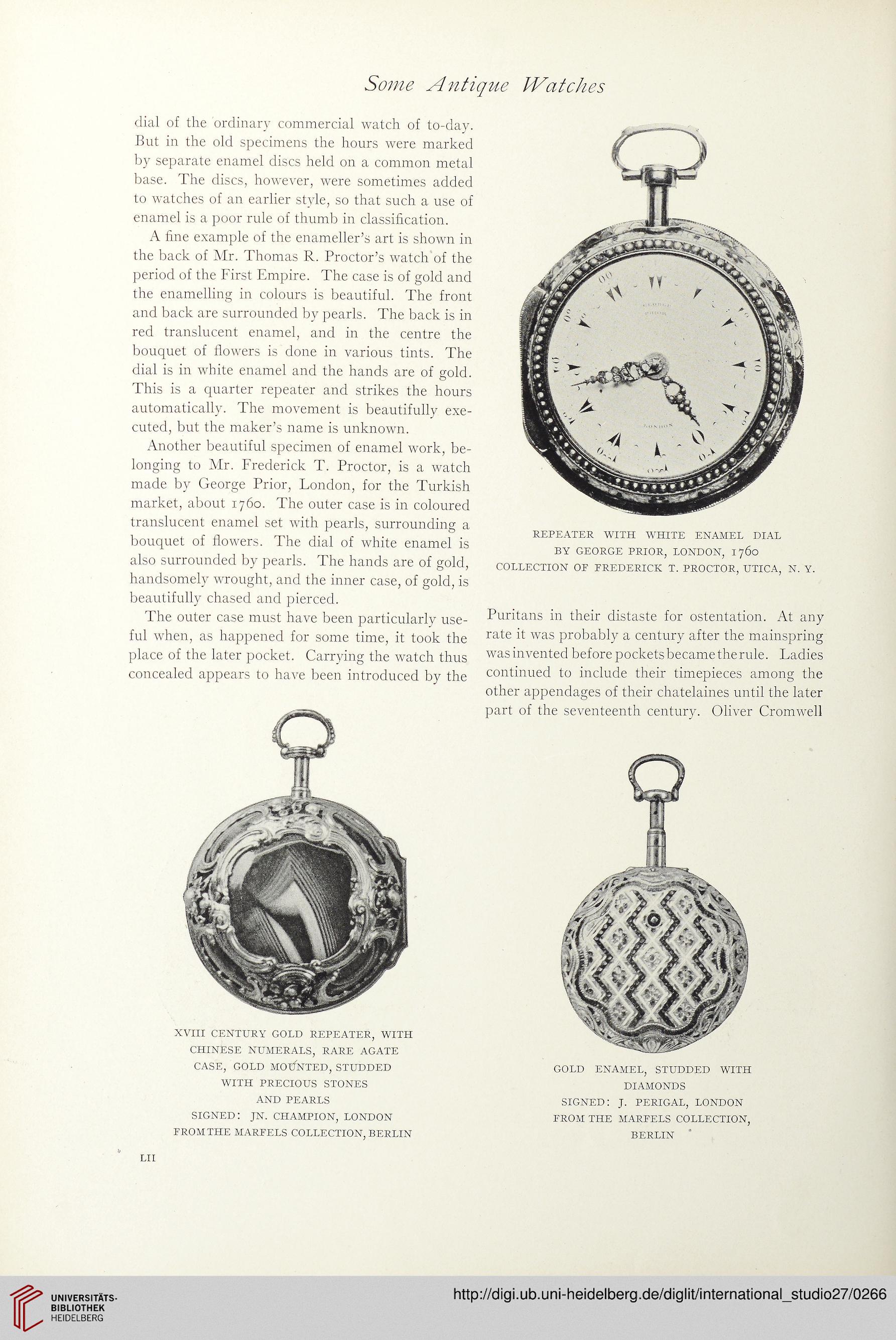Some Antique JVatches
dial of the ordinary commercial watch of to-day.
But in the old specimens the hours were marked
by separate enamel discs held on a common metal
base. The discs, however, were sometimes added
to watches of an earlier style, so that such a use of
enamel is a poor rule of thumb in Classification.
A fine example of the enameller’s art is shown in
the back of Mr. Thomas R. Proctor’s watch of the
period of the First Empire. The case is of gold and
the enamelling in colours is beautiful. The front
and back are surrounded by pearls. The back is in
red translucent enamel, and in the centre the
bouquet of flowers is done in various tints. The
dial is in white enamel and the hands are of gold.
This is a quarter repeater and strikes the hours
automatically. The movement is beautifully exe-
cuted, but the maker’s name is unknown.
Another beautiful specimen of enamel work, be-
longing to Mr. Frederick T. Proctor, is a watch
made by George Prior, London, for the Turkish
market, about 1760. The outer case is in coloured
translucent enamel set with pearls, surrounding a
bouquet of flowers. The dial of white enamel is
also surrounded by pearls. The hands are of gold,
handsomely wrought, and the inner case, of gold, is
beautifully chased and pierced.
The outer case must have been particularly use-
ful when, as happened for some time, it took the
place of the later pocket. Carrying the watch thus
concealed appears to have been introduced by the
XVIII CENTURY GOLD REPEATER, WITH
CHINESE NUMERALS, RARE AGATE
CASE, GOLD MOUNTED, STUDDED
WITH PRECIOUS STONES
AND PEARLS
SIGNED: JN. CHAMPION, LONDON
FROMTHE MARFELS COLLECTION, BERLIN
REPEATER WITH WHITE ENAMEL DIAL
BY GEORGE PRIOR, LONDON, 1760
COLLECTION OF FREDERICK T. PROCTOR, UTICA, N. Y.
Puritans in their distaste for ostentation. At any
rate it was probably a Century after the mainspring
wasinvented beforepocketsbecametherule. Ladies
continued to include their timepieces among the
other appendages of their chatelaines until the later
part of the seventeenth Century. Oliver Cromwell
GOLD ENAMEL, STUDDED WITH
DIAMONDS
SIGNED: J. PERIGAL, LONDON
FROM THE MARFELS COLLECTION,
BERLIN
LII
dial of the ordinary commercial watch of to-day.
But in the old specimens the hours were marked
by separate enamel discs held on a common metal
base. The discs, however, were sometimes added
to watches of an earlier style, so that such a use of
enamel is a poor rule of thumb in Classification.
A fine example of the enameller’s art is shown in
the back of Mr. Thomas R. Proctor’s watch of the
period of the First Empire. The case is of gold and
the enamelling in colours is beautiful. The front
and back are surrounded by pearls. The back is in
red translucent enamel, and in the centre the
bouquet of flowers is done in various tints. The
dial is in white enamel and the hands are of gold.
This is a quarter repeater and strikes the hours
automatically. The movement is beautifully exe-
cuted, but the maker’s name is unknown.
Another beautiful specimen of enamel work, be-
longing to Mr. Frederick T. Proctor, is a watch
made by George Prior, London, for the Turkish
market, about 1760. The outer case is in coloured
translucent enamel set with pearls, surrounding a
bouquet of flowers. The dial of white enamel is
also surrounded by pearls. The hands are of gold,
handsomely wrought, and the inner case, of gold, is
beautifully chased and pierced.
The outer case must have been particularly use-
ful when, as happened for some time, it took the
place of the later pocket. Carrying the watch thus
concealed appears to have been introduced by the
XVIII CENTURY GOLD REPEATER, WITH
CHINESE NUMERALS, RARE AGATE
CASE, GOLD MOUNTED, STUDDED
WITH PRECIOUS STONES
AND PEARLS
SIGNED: JN. CHAMPION, LONDON
FROMTHE MARFELS COLLECTION, BERLIN
REPEATER WITH WHITE ENAMEL DIAL
BY GEORGE PRIOR, LONDON, 1760
COLLECTION OF FREDERICK T. PROCTOR, UTICA, N. Y.
Puritans in their distaste for ostentation. At any
rate it was probably a Century after the mainspring
wasinvented beforepocketsbecametherule. Ladies
continued to include their timepieces among the
other appendages of their chatelaines until the later
part of the seventeenth Century. Oliver Cromwell
GOLD ENAMEL, STUDDED WITH
DIAMONDS
SIGNED: J. PERIGAL, LONDON
FROM THE MARFELS COLLECTION,
BERLIN
LII





